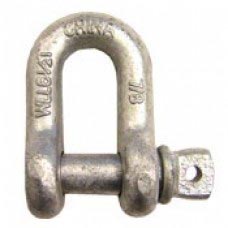The Challenge of Marine Corrosion
 Marine environments are among the harshest settings for rigging hardware. Constant exposure to saltwater, moisture, and extreme weather accelerates corrosion. This corrosion weakens essential components, leading to equipment failure, costly repairs, and potential safety hazards. Avoiding these risks requires selecting coatings specifically engineered to withstand such harsh conditions. Choosing the right protective coating or finish is not just about reducing rust; it’s about extending equipment lifespan, minimizing downtime, and ensuring reliable performance.
Marine environments are among the harshest settings for rigging hardware. Constant exposure to saltwater, moisture, and extreme weather accelerates corrosion. This corrosion weakens essential components, leading to equipment failure, costly repairs, and potential safety hazards. Avoiding these risks requires selecting coatings specifically engineered to withstand such harsh conditions. Choosing the right protective coating or finish is not just about reducing rust; it’s about extending equipment lifespan, minimizing downtime, and ensuring reliable performance.
Protective Coatings for Marine Rigging Hardware: What Works Best?
In marine environments, the performance of rigging hardware depends heavily on the protective coating applied to its surface. These coatings provide a barrier against corrosion, impact, and chemical damage. Here’s a detailed look at some of the most trusted coatings for rigging hardware in corrosive environments.
- Hot-Dip Galvanized (HDG): A Heavy-Duty Workhorse - Hot-dip galvanizing involves dipping steel components into molten zinc, creating a durable, corrosion-resistant layer. The resulting zinc coating bonds tightly to the steel, offering excellent resistance to rust and abrasion. In heavy-duty environments such as offshore platforms and commercial shipping, HDG components are valued for their ability to withstand saltwater immersion while offering cost-effective protection. While the surface may appear rough and industrial, its self-healing properties ensure continued protection even when scratched.
- Stainless Steel: The Ultimate Rust Shield - Stainless steel is often considered the gold standard for marine hardware due to its exceptional corrosion resistance. Containing chromium, stainless steel forms a protective oxide layer that defends against rust even in direct contact with saltwater. This material is ideal for recreational boats, sailboats, and high-end yacht fittings where performance and appearance matter. However, its higher cost and susceptibility to localized crevice corrosion in certain conditions require careful consideration.
- Zinc Electroplating: Light-Duty Defense - Zinc electroplating applies a thin layer of zinc through an electrochemical process. While effective for light-duty applications, its limited saltwater resistance makes it better suited for hardware exposed only occasionally to marine environments. Its smooth, polished finish works well for decorative or non-critical components but lacks the longevity for fully submerged or harsh conditions.
- Powder Coating: Durable and Decorative - Powder coating is a versatile option that adds durability and aesthetic appeal. A dry powder is electrostatically applied and cured in this process to form a strong, chip-resistant layer. Marine hardware with powder coating is often used for exposed components requiring both corrosion resistance and a clean, customized appearance. However, it’s less effective when fully submerged, as breaches in the coating can allow corrosion to penetrate.
- Epoxy Coatings: Heavy-Duty Protection Under Pressure - Epoxy coatings create an exceptionally thick, waterproof barrier through a resin-based application. Known for their resistance to chemicals, water, and abrasion, epoxy-coated hardware is commonly used in the harshest marine environments, such as oil rigs and structural support systems. Multiple layers can be applied for maximum protection, though the coating can become brittle over time, especially under extreme mechanical stress.
Choosing the Right Coating: What to Consider
Selecting the ideal coating for rigging hardware means balancing multiple factors, including:
- Environmental Severity: Evaluate the level of saltwater exposure and the risk of chemical corrosion.
- Application Type: Consider whether the hardware will be fully submerged, exposed to splashing, or used in humid air.
- Maintenance Needs: Weigh the ongoing maintenance required for some coatings versus the longer-term protection others provide.
- Budget Constraints: Factor initial coating costs against expected equipment lifespan and potential repair expenses.
Long-Term Durability in Marine Conditions
The right coating can be the difference between prolonged operational success and frequent equipment failure. Hot-dip galvanized coatings balance affordability and protection for heavy marine use, while stainless steel offers unmatched rust resistance for lighter-duty, high-end applications. Understanding environmental conditions, maintenance expectations, and budget limitations ensures businesses can choose the best coatings, keeping operations smooth and safe even in the harshest marine environments.
Related Reading